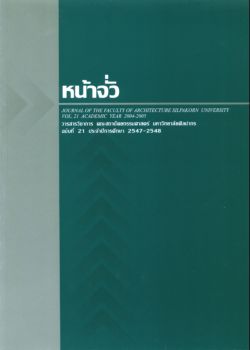สถานการณ์ของการใช้ผนังอะลูมิเนียมคอมโพสิตในประเทศไทย
Keywords:
อะลูมิเนียมคอมโพสิต, ผนังภายนอก, แคล็ดดิ้ง, Aluminum composite material, Exterior wall, CladdingAbstract
บทความนี้เขียนขึ้นจากผลการศึกษาในโครงการ “การประยุกต์แผ่นผนังอะลูมิเนียมคอมโพสิต สําหรับอาคารพักอาศัย" ซึ่งได้รวบรวมข้อมูลจากผู้จําหน่ายและสัมภาษณ์บุคคลที่เกี่ยวข้อง และได้ทําการสํารวจโครงการก่อสร้างขนาดกลางหรือขนาดเล็กที่ใช้ผนังอะลูมิเนียมคอมโพสิต ระหว่างเดือนตุลาคม 2547 - มีนาคม 2548 เพื่อสะท้อนให้เห็นภาพรวมของอุตสาหกรรม และปัญหาการใช้วัสดุก่อสร้างชนิดนี้ในประเทศไทย
แผ่นอะลูมิเนียมคอมโพสิตถูกนําเข้ามาใช้เป็นผนังภายนอกของอาคารสูงในประเทศไทย เมื่อประมาณ 10 กว่าปีมาแล้ว นับเป็นผลิตภัณฑ์ที่ได้รับความนิยม และมีการขยายตัวของตลาดสูงขึ้นอย่างต่อเนื่องและรวดเร็ว ปัจจุบันมีผู้จําหน่ายมากถึง 30 กว่าราย จึงมีการแข่งขันทางธุรกิจสูง แนวโน้มการใช้งานได้ขยายตัวจากอาคารสูง หรืออาคารสาธารณะที่มีมาตรฐานการออกแบบและการก่อสร้างที่ดีไปสู่อาคารประเภทอื่น และโครงการขนาดเล็ก ซึ่งต้องการให้ตัวอาคารมีสีหรือผิวสําเร็จที่ประณีตสวยงามและนําสมัย ตลาดของแผ่นอะลูมิเนียมคอมโพสิตได้ขยายตัวไปสู่งานก่อสร้างประเภทอื่นเพิ่มขึ้นด้วย เช่น ป้ายโฆษณา ฝ้าเพดาน และงานตกแต่งภายในหรือเฟอร์นิเจอร์ ฯลฯ ประมาณกันว่าปัจจุบันมีความต้องการบริโภคแผ่นอะลูมิเนียมคอมโพสิตในประเทศสูงถึง 700,000 - 1,000,000 ตารางเมตร/ปี ราคาค่าก่อสร้างเฉลี่ยของผนังภายนอกอาคาร ประมาณ 2,700 - 3,500 บาท/ตารางเมตร (รวมโครงเหล็ก) ปัญหาของอุตสาหกรรมและการก่อสร้างที่เป็นอยู่ คือ ผลิตภัณฑ์ในท้องตลาดมีมาตรฐานวัสดุและราคาที่แตกต่างกันมาก ซึ่งยากแก่การตรวจสอบคุณภาพและการควบคุมงานก่อสร้าง การแข่งขันด้านราคามีผลให้มาตรฐานวัสดุหรือการก่อสร้าง ในหลายโครงการลดลงไปด้วย โดยเฉพาะความประณีตเรียบร้อยของฝีมือช่าง ซึ่งอาจมีผลต่ออายุการใช้งาน และความเชื่อมั่นในคุณภาพผลิตภัณฑ์หรือระบบผนังชนิดนี้ได้ในอนาคต ทุกฝ่ายที่เกี่ยวข้องจึงควรร่วมมือกันแก้ปัญหา และพัฒนามาตรฐานการก่อสร้างของผลิตภัณฑ์นี้ให้มีการใช้งานอย่างมีประสิทธิภาพและคุ้มค่ามากขึ้น ซึ่งจะเป็นผลดีต่อธุรกิจ อุตสาหกรรมก่อสร้าง และเศรษฐกิจของประเทศได้ในระยะยาวต่อไป
Situation on the Use of Aluminum Composite Claddings in Thailand
This article is based on the results of a study on “The Application of Aluminum Composite Claddings for Residential Buildings”. Data collection was conducted between October 2004 - March 2005 from manufacturers, distributors and interviews with stakeholders. In addition, mediumsmall construction projects using aluminum composite materials (ACM) for exterior claddings were surveyed to obtain an overview of the industry and identify the problems associated with using the productin Thailand.
Thailand has been importing ACM for exterior cladding of high-rise buildings for more than ten years. The product is in great demand with continuous market expansion. Presently more than thirty distributors are in this business and therefore marketing is very competitive. Trends in using ACM claddings have expanded from high-rise, commercial and public buildings with high standards of design and construction, to other building types and smaller projects that require neat modern and beautiful color finishes. Furthermore, the ACM market has also been expanding to other types of construction uses such as signboards, ceilings, interior decoration and furniture for example. The current demand for ACM in Thailand is roughly estimated to be as much as 700,000 -1,000,000 square meters per year while the average construction cost of ACM claddings is approximately 2,700-3,500 Baht per square meter(standard ACM with steel frame). The problem with the industry and the construction is that ACM products that are currently on the market vary greatly in terms of standards and sale prices which make it difficult to test the materials or control the quality of construction. Price competition has led to using poorer quality products and lower construction standards in many projects, especially in the workmanship. Consequently this may reduce the building's life cycle and affect the consumers' confidence in future. All parties concerned should therefore collaborate to alleviate the problems by developing ACM standards and applications that can be highly effective and economical. This will in turn benefit business, the building industry and the country's economy in the long run.





